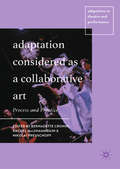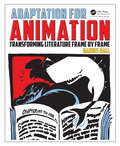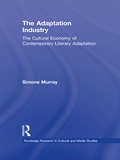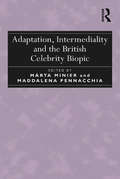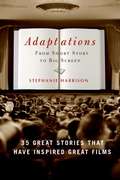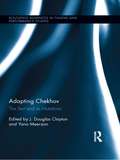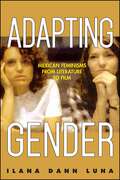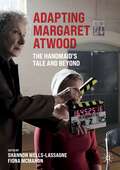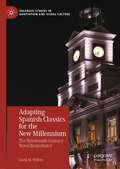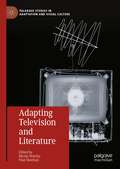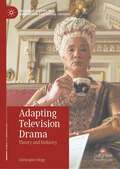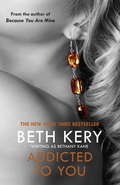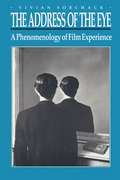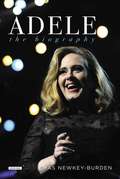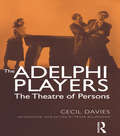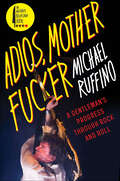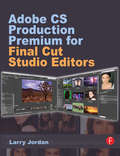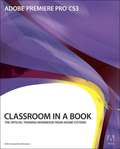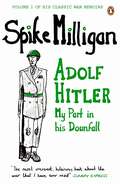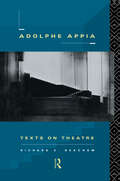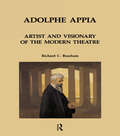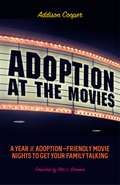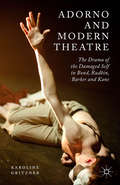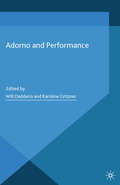- Table View
- List View
Adaptation Considered as a Collaborative Art: Process and Practice (Adaptation in Theatre and Performance)
by Bernadette Cronin Rachel MagShamhráin Nikolai PreuschoffThis book examines the processes of adaptation across a number of intriguing case studies and media. Turning its attention from the 'what' to the 'how' of adaptation, it serves to re-situate the discourse of adaptation studies, moving away from the hypotheses that used to haunt it, such as fidelity, to questions of how texts, authors and other creative practitioners (always understood as a plurality) engage in dialogue with one another across cultures, media, languages, genders and time itself. With fifteen chapters across fields including fine art and theory, drama and theatre, and television, this interdisciplinary volume considers adaptation across the creative and performance arts, with a single focus on the collaborative.
Adaptation for Animation: Transforming Literature Frame by Frame
by Hannes RallTalented animation artists often neglect successful storytelling in favor of strong visuals, but now you can have both with this complete guide to adaptation for animation. Veteran independent filmmaker Hannes Rall teaches you how to draw and adapt inspiration from copyright-free materials like fairy tales, myths, and classic literature, making it easier than ever to create your own compelling narrative. Particular focus is given to making the adequate narrative and visual choices when transferring a text from page to screen: How to create a successful adaptation. With sections on subjects like transcultural adaptations, visual poetry and production design, this book is just the right mix of practical advice, lavish illustrations, and industry case studies to give you everything you need to start adapting your story today. Key features: Learn to apply concepts of adapting classic and modern literature for animation in different techniques Exclusive interviews with animation legends Giannalberto Bendazzi, John Canemaker, Ishu Patel and Georges Schwizgebel Lavishly illustrated with 325 color images (mostly never published before) that give thrilling insights into the visual development of award-winning animated adaptations
The Adaptation Industry: The Cultural Economy of Contemporary Literary Adaptation (Routledge Research in Cultural and Media Studies)
by Simone MurrayAdaptation constitutes the driving force of contemporary culture, with stories adapted across an array of media formats. However, adaptation studies has been concerned almost exclusively with textual analysis, in particular with compare-and-contrast studies of individual novel and film pairings. This has left almost completely unexamined crucial questions of how adaptations come to be made, what are the industries with the greatest stake in making them, and who the decision-makers are in the adaptation process. The Adaptation Industry re-imagines adaptation not as an abstract process, but as a material industry. It presents the adaptation industry as a cultural economy of six interlocking institutions, stakeholders and decision-makers all engaged in the actual business of adapting texts: authors; agents; publishers; book prize committees; scriptwriters; and screen producers and distributors. Through trading in intellectual property rights to cultural works, these six nodal points in the adaptation network are tightly interlinked, with success for one party potentially auguring for success in other spheres. But marked rivalries between these institutional forces also exist, with competition characterizing every aspect of the adaptation process. This book constructs an overdue sociology of contemporary literary adaptation, never losing sight of the material and institutional dimensions of this powerful process.
Adaptation, Intermediality and the British Celebrity Biopic
by Márta Minier Maddalena PennacchiaBeginning with the premise that the biopic is a form of adaptation and an example of intermediality, this collection examines the multiplicity of 'source texts' and the convergence of different media in this genre, alongside the concurrent issues of fidelity and authenticity that accompany this form. The contributors focus on big and small screen biopics of British celebrities from the late twentieth and twenty-first centuries, attending to their myth-making and myth-breaking potential. Related topics are the contemporary British biopic's participation in the production and consumption of celebrated lives, and the biopic's generic fluidity and hybridity as evidenced in its relationship to such forms as the bio-docudrama. Offering case studies of film biographies of literary and cultural icons, including Elizabeth I, Elizabeth II, Diana Princess of Wales, John Lennon, Shakespeare, Jane Austen, Beau Brummel, Carrington and Beatrix Potter, the essays address how British identity and heritage are interrogated in the (re)telling and showing of these lives, and how the reimagining of famous lives for the screen is influenced by recent processes of manufacturing celebrity.
Adaptations: 35 Great Stories That Have Inspired Great Films
by Stephanie HarrisonAn Eclectic Collection of Fiction That Inspired Film Memento, All About Eve, Rear Window, Rashomon, and 2001: A Space Odyssey are all well-known and much-loved movies, but what is perhaps a lesser-known fact is that all of them began their lives as short stories. Adaptations gathers together 35 pieces that have been the basis for films, many from giants of American literature (Hemingway, Fitzgerald) and many that have not been in print for decades (the stories that inspired Bringing Up Baby, Meet John Doe, and All About Eve). Categorized by genre, and featuring movies by master directors such as Steven Spielberg, Stanley Kubrick, Robert Altman, Frank Capra, and John Ford, as well as relative newcomers such as Chris Eyre and Christopher Nolan, Adaptations offers insight into the process of turning a short story into a screenplay, one that, when successful, doesn't take drastic liberties with the text upon which it is based, but doesn't mirror its source material too closely either. The stories and movies featured in Adaptations include: *Philip K. Dick's "The Minority Report," which became the 2002 blockbuster directed by Steven Spielberg and starring Tom Cruise *"The Harvey Pekar Name Story" by reclusive graphic artist Harvey Pekar, whose life was the inspiration for American Splendor, winner of the 2003 Sundance Grand Jury Prize *Hagar Wilde's "Bringing Up Baby," the basis of the classic film Bringing Up Baby, anthologized here for the first time ever *"The Swimmer" by John Cheever, an example of a highly regarded story that many feared might prove unadaptable *The predecessor to the beloved holiday classic A Christmas Story, "Red Ryder Nails the Hammond Kid" by Jean Shepherd Whether you're a fiction reader or a film buff, Adaptations is your behind-the-scenes look at the sometimes difficult, sometimes brilliantly successful process from the printed page to the big screen.
Adapting Chekhov: The Text and its Mutations (Routledge Advances in Theatre & Performance Studies #23)
by J. Douglas Clayton Yana MeerzonThis book considers the hundred years of re-writes of Anton Chekhov’s work, presenting a wide geographical landscape of Chekhovian influences in drama. The volume examines the elusive quality of Chekhov’s dramatic universe as an intricate mechanism, an engine in which his enigmatic characters exist as the dramatic and psychological ciphers we have been de-coding for a century, and continue to do so. Examining the practice and the theory of dramatic adaptation both as intermedial transformation (from page to stage) and as intramedial mutation, from page to page, the book presents adaptation as the emerging genre of drama, theatre, and film. This trend marks the performative and social practices of the new millennium, highlighting our epoch’s need to engage with the history of dramatic forms and their evolution. The collection demonstrates that adaptation as the practice of transformation and as a re-thinking of habitual dramatic norms and genre definitions leads to the rejuvenation of existing dramatic and performative standards, pioneering the creation of new traditions and expectations. As the major mode of the storytelling imagination, adaptation can build upon and drive the audience’s horizons of expectations in theatre aesthetics. Hence, this volume investigates the original and transformative knowledge that the story of Chekhov’s drama in mutations offers to scholars of drama and performance, to students of modern literatures and cultures, and to theatre practitioners worldwide.
Adapting Gender: Mexican Feminisms from Literature to Film (SUNY series in Latin American Cinema)
by Ilana Dann LunaAdapting Gender offers a cogent introduction to Mexico's film industry, the history of women's filmmaking in Mexico, a new approach to adaptation as a potential feminist strategy, and a cultural history of generational changes in Mexico. Ilana Dann Luna examines how adapted films have the potential to subvert not only the intentions of the source text, but how they can also interrupt the hegemony of gender stereotypes in a broader socio-political context. Luna follows the industrial shifts that began with Salinas de Gortari's presidency, which made the long 1990s the precise moment in which subversive filmmakers, particularly women, were able to participate more fully in the industry and portrayed the lived experiences of women and non-gender-conforming men. The analysis focuses on Busi Cortés's El secreto de Romelia (1988), an adaptation of Rosario Castellanos's short novel El viudo Román (1964); Sabina Berman and Isabelle Tardán's Entre Pancho Villa y una mujer desnuda (1996), an adaptation of Berman's own play, Entre Villa y una mujer desnuda (1992); Guita Schyfter's Novia que te vea (1993), an adaptation of Rosa Nissán's eponymous novel (1992); and Jaime Humberto Hermosillo's De noche vienes, Esmeralda (1997), an adaptation of Elena Poniatowska's short story "De noche vienes" (1979). These adapted texts established a significant alternative to monolithic notions of national (gendered) identity, while critiquing, updating, and even queering, notions of feminism in the Mexican context.
Adapting Margaret Atwood: The Handmaid's Tale and Beyond (Palgrave Studies in Adaptation and Visual Culture)
by Shannon Wells-Lassagne Fiona McMahonThis book engages with Margaret Atwood’s work and its adaptations. Atwood has long been appreciated for her ardent defence of Canadian authors and her genre-bending fiction, essays, and poetry. However, a lesser-studied aspect of her work is Atwood’s role both as adaptor and as source for adaptation in media as varied as opera, television, film, or comic books. Recent critically acclaimed television adaptations of the novels The Handmaid’s Tale (Hulu) and Alias Grace (Amazon) have rightfully focused attention on these works, but Atwood’s fiction has long been a source of inspiration for artists of various media, a seeming corollary to Atwood’s own tendency to explore the possibilities of previously undervalued media (graphic novels), genres (science-fiction), and narratives (testimonial and historical modes). This collection hopes to expand on other studies of Atwood’s work or on their adaptations to focus on the interplay between the two, providing an interdisciplinary approach that highlights the protean nature of the author and of adaptation.
Adapting Spanish Classics for the New Millennium: The Nineteenth-Century Novel Remediated (Palgrave Studies in Adaptation and Visual Culture)
by Linda M. WillemThe twenty-first-century's turn away from fidelity-based adaptations toward more innovative approaches has allowed adapters from Spain, Argentina, and the United States to draw upon Spain's rich body of nineteenth-century classics to address contemporary concerns about gender, sexuality, race, class, disability, celebrity, immigration, identity, social justice, and domestic violence. This book provides a snapshot of visual adaptations in the first two decades of the new millennium, examining how novelistic material from the past has been remediated for today's viewers through film, television, theater, opera, and the graphic novel. Its theoretical approach refines the binary view of adapters as either honoring or opposing their source texts by positing three types of adaptation strategies: salvaging (which preserves old stories by giving them renewed life for modern audiences), utilizing (which draws upon a pre-existing text for an alternative purpose, building upon the story and creating a shift in emphasis without devaluing the source material), and appropriation (which involves a critique of the source text, often with an attempt to dismantle its authority). Special attention is given to how adapters address audiences that are familiar with the source novels, and those that are not. This examination of the vibrant afterlife of classic literature will be of interest to scholars and educators in the fields of adaptation, media, Spanish literature, cultural studies, performance, and the graphic arts.
Adapting Television and Literature (Palgrave Studies in Adaptation and Visual Culture)
by Blythe Worthy Paul SheehanAdapting Television and Literature is an incisive collection of essays that explores the growing sub-category of television adaptations of literature and poetics. Each chapter questions inflexible notions of film / literature and adaptation / intertext, focusing judiciously on emergent or overlooked media and literary forms. These lines of enquiry embrace texts both within and beyond ‘adaptation proper’, to reveal the complex relationships between literary works, television adaptations, and related dialogues of textual interconnectivity. Adapting Television and Literature proposes, in particular, a ‘re-seeing’ of four genres pivotal to television and its history: caustic comedy, which claims for itself more freedoms than other forms of scripted television; auteurist outlaw drama, an offbeat, niche genre that aligns a fixation on lawbreakers with issues of creative control; young adult reinventions that vitalise this popular, yet under-examined area of television studies; and transcultural exchanges, which highlight adaptations beyond the white, Anglo-American programming that dominates ‘peak TV’. Through these genres, Adapting Television and Literature examines the creative resources of adaptation, plotting future paths for enquiries into television, literature and transmedial storytelling.
Adapting Television Drama: Theory and Industry (Palgrave Studies in Adaptation and Visual Culture)
by Christopher HoggThis book explores adaptation in its various forms in contemporary television drama. It considers the mechanics of adaptation as an ever-more prevalent form of production, most notably in the reworking of literary sources for television. It also explores the broader process through which the television industry as a whole is currently making necessary adaptations in how it tells stories, especially in relation to important concerns of equality, diversity and inclusion. Offering and analysing 16 original interviews with leading British television producers, writers, directors, production designers, casting directors and actors, and with a particular focus on female and/or minority-ethnic industry perspectives, the book examines some of the key professional and creative approaches behind television adaptations today. The book connects these industry insights to the existing conceptual and critical frameworks of television studies and adaptation studies, illuminating the unique characteristics of television adaptation as a material mode of production, and revealing television itself as an inherently adaptive artform.
Addicted To You: One Night of Passion Book 1 (One Night of Passion)
by Beth KeryFrom the New York Times ebook bestselling author of the Because You Are Mine series and The Affair, for fans for Sylvia Day, J. Kenner and Maya Banks. This is the first in Beth Kery's One Night of Passion series about a group of connected characters who each begin their romance with a night of impulsive, steamy sex...Irish film director Rill Pierce fled to the tiny, backwoods town of Vulture's Canyon, seeking sanctuary and solitude after a devastating tragedy. Once, his raw sex appeal and sultry Irish accent made women across the globe swoon. Now, he's barely recognisable... But Katie Hughes, his best friend's sister, is not the type of woman to give up on a man like Rill. She blazes into Vulture's Canyon determined to save him from himself. Instead, she finds herself unleashing years of pent-up passion. In a storm of hunger and need, Katie and Rill forget themselves and the world. But will Rill's insatiable attraction to Katie heal his pain - or will it just feed the darkness within him?***This was previously published under the author's pseudonym Bethany Kane***Lose yourself in One Night of Passion: Addicted To You, Bound To You, Captured By You, Exposed To You, Only For You.
The Address of the Eye: A Phenomenology of Film Experience
by Vivian SobchackCinema is a sensuous object, but in our presence it becomes also a sensing, sensual, sense-making subject. Thus argues Vivian Sobchack as she challenges basic assumptions of current film theory that reduce film to an object of vision and the spectator to a victim of a deterministic cinematic apparatus. Maintaining that these premises ignore the material and cultural-historical situations of both the spectator and the film, the author makes the radical proposal that the cinematic experience depends on two "viewers" viewing: the spectator and the film, each existing as both subject and object of vision. Drawing on existential and semiotic phenomenology, and particularly on the work of Merleau-Ponty, Sobchack shows how the film experience provides empirical insight into the reversible, dialectical, and signifying nature of that embodied vision we each live daily as both "mine" and "another's." In this attempt to account for cinematic intelligibility and signification, the author explores the possibility of human choice and expressive freedom within the bounds of history and culture.
Adele: The Biography
by Chas Newkey-BurdenAdele's soulful voice, catchy hits, and vulnerable personality have won her critical acclaim and widespread popularity. She has topped the charts in 18 countries and swept the top awards at the 2012 Grammys--but who is she? How has her tempestuous life that influenced her heartbreaking tracks? How did she overcome the challenges that threatened to derail her career? InAdele, veteran celebrity biographer Chas Newkey-Burden traces her story from her childhood in London, where she began singing at the age of four. During her teenage years she wrote her own music and attended the BRIT school, alongside the likes of Leona Lewis. After posting demos on her MySpace webpage, she earned a record deal and quickly captured hearts. Adele remains an unlikely icon. Her looks are unusual in a formulaic world of celebrity image, she suffers badly with pre-stage nerves, and she once canceled a crucial promotional trip to the U. S. because she felt too down to travel. This is a full, unflinching portrait of a genuine talent and inspiring, uncompromising woman--the curvy girl next door who conquered the world.
The Adelphi Players: The Theatre of Persons
by Dr Cecil DaviesCecil Davies' The Adelphi Players: The Theatre of Persons represents a uniquely interesting contribution to our understanding of touring British theatre in the mid-twentieth-century, post-war period. This book will interest everyone - whether student, academic or general reader - who wants to know more about issues concerning the recent history of British theatre. In their values and aims, the Adelphi Players pre-empted many of the post-war developments that we associate with the non-commercial, fringe and community theatre movement. In Richard Heron Ward founder of the Adelphi-Players, we encounter a dramatist, novelist, essayist and poet who has been unusually neglected in terms of our appreciation of the English literature of the broad left in the 1930s, `40s and `50s. The Adelphi Players has been edited by Peter Billingham, who has also provided an introduction placing Ward and the Adelphi players in the wider social, cultural and ideological context.
Adios, Motherfucker: A Gentleman's Progress Through Rock and Roll
by Michael RuffinoA blend of This Is Spinal Tap and Fear and Loathing in Las Vegas, the cult classic confessions of a debauched rock ’n’ roller and his adventures in excess on the ’80s hair-metal nostalgia tour through Middle America, now in a revised and updated edition. Once upon a time at the start of the new century, the unheard-of Unband got a chance to drink, fight, and play loud music with ’80s metal bands like Dio and Def Leppard. To the mix they brought illegal pyrotechnics, a giant red inflatable hand with movable digits, a roadie dubiously named Safety Bear, a high tolerance for liver damage, and an infectious love of rock & roll and everything it represents.Unband bassist Michael Ruffino takes us on an epic joyride across a surrealistic American landscape where we meet mute Christian groupies, crack-smoking Girl Scouts, beer-drinking chimps, and thousands of head-bangers who cannot accept that hair metal is dead. Here, too, are uncensored portraits of Ronnie James Dio, Anthrax, Sebastian Bach, Lemmy of Motorhead, and others.Adios, Motherfucker is gonzo rock storytelling at its finest—excessive, incendiary, intelligent, hilarious, and utterly original.
Adobe CS Production Premium for Final Cut Studio Editors
by Larry JordanPut the Adobe Production Premium toolset to use throughout your production to realize astonishing efficiencies and creative opportunities. Adobe's CS tools are the perfect compliment to Final Cut Studio, with tools that improve your preproduction, production and postproduction capabilities in leaps and bounds. Move seamlessly between the toolsets -- always using the best tool for the job with the real-world practice that you get in this guide.
Adobe Premiere Pro CS3
by Adobe PressThe best-selling guide to Adobe's powerful digital video editing application, now fully updated to cover the newest version of Premiere Pro.
Adobe Premiere Pro Power Tips: Secrets, Shortcuts, and Techniques
by Larry JordanStop wasting time! Let Larry Jordan’s Adobe Premiere Pro Power Tips power your editing. Whether you are migrating to Premiere Pro from other editing software, or you are a long-time Premiere editor, this must-have guide is packed with hundreds of bite-sized tips to get you up and running in no time. Written with humor and deep technical understanding, Jordan shows you the secrets, shortcuts, tips, and techniques you need to make the most of Premiere Pro. Like any professional production, the book starts with planning, then flows into scripting, shooting, logging, editing, audio mixing, and final output with hundreds of Power Tips covering Story, Prelude, Premiere, Audition and Adobe Media Encoder. These Power Tips will: * Speed your editing* Expand your knowledge* Wow your clients (and keep them coming back for more!) Visit the companion website (www.focalpress.com/9780415657075) to see video demonstrations that accompany this book.
Adolf Hitler: My Part in his Downfall (Spike Milligan War Memoirs)
by Spike MilliganVolume one of Spike Milligan's legendary memoirs is a hilarious, subversive first-hand account of WW2'The most irreverent, hilarious book about the war that I have ever read' Sunday Express'Close in stature to Lewis Carroll and Edward Lear in his command of the profound art of nonsense' Guardian______________'At Victoria station the R.T.O. gave me a travel warrant, a white feather and a picture of Hitler marked "This is your enemy". I searched every compartment, but he wasn't on the train . . .' In this, the first of Spike Milligan's uproarious recollections of life in the army, our hero takes us from the outbreak of war in 1939 ('it must have been something we said'), through his attempts to avoid enlistment ('time for my appendicitis, I thought') and his gunner training in Bexhill ('There was one drawback. No ammunition') to the landing at Algiers in 1943 ('I closed my eyes and faced the sun. I fell down a hatchway'). Filled with bathos, pathos and gales of ribald laughter, this is a barely sane helping of military goonery and superlative Milliganese.______________ 'That absolutely glorious way of looking at things differently. A great man' Stephen Fry'Milligan is the Great God to all of us' John Cleese 'The Godfather of Alternative Comedy' Eddie Izzard 'Manifestly a genius, a comic surrealist genius and had no equal' Terry Wogan 'A totally original comedy writer' Michael Palin
Adolphe Appia: Texts on Theatre (Contemporary Theatre Studies #Vol. 6)
by Richard C. BeachamAdolphe Appia swept away the foundations of traditional theatre and set the agenda for the development of theatrical practice this century. In Adolphe Appia: Texts on Theatre, Richard Beacham brings together for the first time selections from all his major writings. The publication of these essays, many of which have long been unavailable in English, represents a significant addition to our understanding of the development of theatrical art. It will be an invaluable sourcebook for theatre students and welcomed as an important contribution to the literature of the modern stage.
Adolphe Appia: Texts On Theatre (Contemporary Theatre Studies #Vol. 6)
by Richard C. BeachamFirst Published in 1994. Routledge is an imprint of Taylor & Francis, an informa company.
Adoption at the Movies: A Year of Adoption-Friendly Movie Nights to Get Your Family Talking
by Rita L. Soronen Addison CooperGet your family talking about adoption with the ultimate collection of films to help the whole family to explore their feelings in a fun and safe way. With a film for each week of the year, Addison Cooper has compiled the best movies, new and old, for family-friendly viewing. Among those featured are Finding Dory, Frozen, Paddington, Teenage Mutant Ninja Turtles, Kung Fu Panda, Star Wars, Divergent, The Blind Side and I am Sam. Carefully selected, the movies included will help families to comfortably talk about important adoption-related topics. They are accompanied by descriptions of the themes and ideas to get the conversations started. Helping all members of the family to explore both the pain and joy of adoption, they cover a range of issues which can arise such as culture, identity, control, and reunification. With something for everyone - from kids, to teens, to grown-ups - this is a must-have for all adoptive families.
Adorno and Modern Theatre: The Drama of the Damaged Self in Bond, Rudkin, Barker and Kane
by K. GritznerAdorno and Modern Theatre explores the drama of Edward Bond, David Rudkin, Howard Barker and Sarah Kane in the context of the work of leading philosopher Theodor W. Adorno (1903-1969). The book engages with key principles of Adorno's aesthetic theory and cultural critique and examines their influence on a generation of seminal post-war dramatists.
Adorno and Performance (Performance Philosophy)
by Will Daddario Karoline GritznerAdorno and Performance offers the first comprehensive examination of the vital role of performance within the philosophy of Theodor W. Adorno. Capacious in its ramifications for contemporary life, the term 'performance' here unlocks Adorno's dialectical thought process, which aimed at overcoming the stultifying uniformity of instrumental reason.
